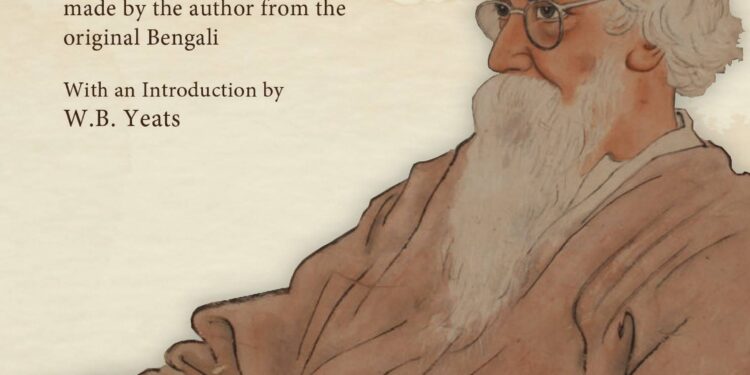Gitanjali Poem Summary by Rabindranath Tagore
Gitanjali, also known as “Song Offerings,” is a collection of poems by Rabindranath Tagore, the renowned Bengali poet and philosopher. First published in 1910, it is a significant work in Tagore’s literary career and was awarded the Nobel Prize in Literature in 1913.
Gitanjali Poem Summary by Rabindranath Tagore-The collection consists of 103 poems that explore themes of love, spirituality, nature, and the relationship between humans and the divine. In this summary, we will provide an overview of the key themes and motifs found in Gitanjali.
One of the central themes in Gitanjali is the pursuit of spiritual enlightenment and the yearning for a deeper connection with the divine. Tagore expresses his devotion and surrender to God in several poems, presenting himself as a humble seeker in search of transcendence.
Also Read-
- “The Red Wheelbarrow” by William Carlos Williams Poem Summary
- “She Walks in Beauty” by Lord Byron Poem Summary
- “Annabel Lee” by Edgar Allan Poe Poem Summary
- “Ozymandias” by Percy Bysshe Shelley Poem Summary
Gitanjali Poem Summary by Rabindranath Tagore-In “Song 1,” he writes, “Thou hast made me endless, such is thy pleasure. This frail vessel thou emptiest again and again, and fillest it ever with fresh life.” Here, Tagore emphasizes the idea of surrendering oneself to the divine will, acknowledging that God is the ultimate source of life and fulfillment.
Gitanjali Poem Summary by Rabindranath Tagore-Nature also plays a significant role in Gitanjali, with Tagore often using natural imagery to convey deeper philosophical truths. In many poems, he celebrates the beauty of the natural world and sees it as a reflection of the divine. For example, in “Song 2,” he writes, “I ask for a moment’s indulgence to sit by thy side.
The works that I have in hand I will finish afterwards. Away from the sight of thy face my heart knows no rest nor respite.” Tagore’s use of nature imagery here enhances the sense of serenity and tranquility, suggesting that being in nature brings him closer to God.
Gitanjali Poem Summary by Rabindranath Tagore-Love, both divine and human, is another prominent theme in Gitanjali. Tagore explores the depths of love and its transformative power. In many poems, he expresses his longing for a spiritual union with the divine, describing it as a passionate love affair. In “Song 9,” he writes,
“In the dusky path of a dream I went to seek the love who was mine in a former life. Her house stood at the end of a desolate street.” This poem reflects the poet’s yearning for the divine presence, which he perceives as a reunion with a long-lost lover.
Gitanjali Poem Summary by Rabindranath Tagore-Moreover, Tagore delves into the complexities of human relationships, particularly the dynamics between lovers and the pain of separation. In “Song 11,” he writes, “Where dost thou stand behind them all, my lover, hiding thyself in the shadows?
Gitanjali Poem Summary by Rabindranath Tagore-They push thee and pass thee by on the dusty road, taking thee for naught.” This poem highlights the anguish of unrequited love and the feeling of being overlooked or ignored by the beloved.
Throughout Gitanjali, Tagore’s poetic language and imagery create a sense of ethereal beauty and evoke deep emotions. He employs metaphors and symbols to convey profound spiritual insights and to capture the essence of his experiences.
Gitanjali Poem Summary by Rabindranath Tagore-The poems are filled with vivid descriptions of landscapes, flowers, birds, and various elements of nature, creating a rich tapestry of imagery that adds to the overall atmosphere of mysticism and wonder.
Gitanjali Poem Summary by Rabindranath Tagore-In addition to the thematic elements, Gitanjali also reflects Tagore’s broader philosophical and cultural beliefs. Tagore was a proponent of universalism and believed in the essential unity of all religions and cultures. In Gitanjali, he incorporates elements of Hinduism, Islam, and other religious traditions, emphasizing the universality of spiritual truths and the interconnectedness of all beings.
Conclusion
FAQ.
Q: When was Gitanjali published?
A: Gitanjali was first published in 1910.
Q: How many poems are included in Gitanjali?
A: Gitanjali consists of 103 poems.
Q: Did Rabindranath Tagore win any awards for Gitanjali?
A: Yes, Rabindranath Tagore was awarded the Nobel Prize in Literature in 1913 for his collection of poems, Gitanjali.
Q: What are the main themes in Gitanjali?
A: The main themes in Gitanjali include spirituality, the pursuit of enlightenment, the relationship between humans and the divine, love (both divine and human), nature, and the pain of separation.
Q: How does Tagore use nature in Gitanjali?
A: Tagore often uses nature imagery in Gitanjali to convey deeper philosophical truths and to reflect the beauty and harmony of the natural world as a reflection of the divine. Nature serves as a metaphor and symbol for spiritual transcendence and brings the poet closer to God.
Q: What is the significance of love in Gitanjali?
A: Love, both divine and human, is a significant theme in Gitanjali. Tagore explores the transformative power of love and expresses his longing for a spiritual union with the divine. He also delves into the complexities of human relationships, including the pain of unrequited love and the anguish of separation.
Q: What cultural and philosophical beliefs does Gitanjali reflect?
A: Gitanjali reflects Rabindranath Tagore’s broader cultural and philosophical beliefs, including universalism and the essential unity of all religions and cultures. Tagore incorporates elements from various religious traditions, emphasizing the universality of spiritual truths and the interconnectedness of all beings.
Q: Is Gitanjali still relevant today?
A: Yes, Gitanjali remains relevant today as a timeless masterpiece of world literature. Its exploration of universal themes and its lyrical beauty continue to inspire and touch the hearts of readers across generations.

















